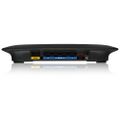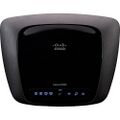Linksys E1000 v2.1
bgn (N300) | |||||||||||||||||
|---|---|---|---|---|---|---|---|---|---|---|---|---|---|---|---|---|---|
| Wireless-N Router | |||||||||||||||||
 | |||||||||||||||||
| Support | |||||||||||||||||
| Wikipedia | |||||||||||||||||
| WikiDevi.wi-cat.ru | |||||||||||||||||
| 3rd Party Firmware | |||||||||||||||||
| dd-wrt | |||||||||||||||||
| OpenWrt |
Incompatible | ||||||||||||||||
| Tomato any flavor | |||||||||||||||||
| Gargoyle |
Status Unknown | ||||||||||||||||
| Platform | |||||||||||||||||
| Brand • Model • Rev |
Linksys E1000 v2.1 | ||||||||||||||||
| Serial number prefix |
CNV2 | ||||||||||||||||
| FCC ID | |||||||||||||||||
| IC ID | |||||||||||||||||
| Type |
wireless router | ||||||||||||||||
| Series |
E1000 | ||||||||||||||||
| CPU1 |
Broadcom BCM5357B0 | ||||||||||||||||
| CPU1 Type |
MIPS 74K | ||||||||||||||||
| CPU1 Speed |
300 MHz | ||||||||||||||||
| Flash1 Chip |
Brand? Model? | ||||||||||||||||
| Flash1 Size |
4 MiB4,194,304 B <br />32,768 Kib <br />4,096 KiB <br />32 Mib <br />0.00391 GiB <br /> (Serial) | ||||||||||||||||
| RAM1 Size |
32 MiB33,554,432 B <br />262,144 Kib <br />32,768 KiB <br />256 Mib <br />0.0313 GiB <br /> | ||||||||||||||||
| RAM1 Chip |
Brand? Model? | ||||||||||||||||
| ETH chip1 |
Broadcom BCM5357B0 | ||||||||||||||||
| Switch |
Broadcom BCM5357B0 | ||||||||||||||||
| Ethernet Port Count |
1-100MbE-WAN 4-100MbE-LAN | ||||||||||||||||
| Wired Standard |
IEEE 802.3i/3u | ||||||||||||||||
| Expansion IF types |
none specified | ||||||||||||||||
| Power |
12 VDC, 0.5 A | ||||||||||||||||
| Connector type |
barrel | ||||||||||||||||
| Serial Port (UART) |
yes | ||||||||||||||||
| JTAG Port |
yes | ||||||||||||||||
| Other | |||||||||||||||||
|
Default IP address: 192.168.1.1 | |||||||||||||||||
| Manuf/OEM/ODM | |||||||||||||||||
| 3rd Party Firmware Support | |||||||||||||||||
| Retail | |||||||||||||||||
| FCC approval date | 13 September 2010 | ||||||||||||||||
| Country of manuf | China | ||||||||||||||||
| Physical | |||||||||||||||||
| Dimensions |
7.95" x 1.34" x 6.3" (202 x 34 x 160 mm) | ||||||||||||||||
| Radio 1 | |||||||||||||||||
| Chip1 |
Broadcom BCM5357B0 | ||||||||||||||||
| Wireless interface OUI |
C0:C1:C0 | ||||||||||||||||
| Antenna Connector Type |
none specified | ||||||||||||||||
| MIMO status |
2x2:2 | ||||||||||||||||
| Wireless Standard |
IEEE 802.11b/g/n | ||||||||||||||||
| 802.11n |
up to 300 Mbps | ||||||||||||||||
| 802.11g |
up to 54 Mbps | ||||||||||||||||
| 802.11b |
up to 11 Mbps | ||||||||||||||||
| WiFi Operating Frequency |
2.4 GHz | ||||||||||||||||
| |||||||||||||||||
For a list of all currently documented Broadcom chipsets with specifications, see Broadcom.
For a list of all currently documented Linksys device with specifications, see Linksys.
- • 300 Mbps - 2SS 2.4GHz 802.11n (40MHz chan.) = N300 class
Overview
E1000 v2.1 serial numbers appear to start with CNV2.
"3763-11200701R" is silkscreened on the board in the FCC photos.
Listed on the 'Linksys routers' page on Wikipedia
The default SSID is probably CiscoXXXXX where XXXXX is the last 5 digits of the serial number. If the device has been configured with Cisco Connect the device will probably have a randomly generated SSID.
Supported by K26RT-N builds of Tomato by Shibby.
Links of Interest
- DD-WRT Firmware Development for Linksys E1000 v2.1
- Tomato Firmware Development for Linksys E1000 v2.1
Flashing
| NOTE: During configuration or flashing a device, the only things that should be hooked to the device is the computer and power. |
Flashing dd-wrt
Supported by dd-wrt as of = 16968
Please enter flashing instrustions here
Flashing Tomato
Please enter flashing instrustions here
JTAG-Serial Info
Serial
Serial Pinouts
This image contains the pin outs for the E1000 v2.0 version, however
these pin outs are identical to the v2.1 version of the Linksys E1000 v2.1
Router.
Serial Recovery
Serial Interfaces
You need a level shifting 3.3v TTL adapter. You can get Nokia CA-42
cables online for about 3.00 and cut the phone end off. Then you have to
figure out what each wire does. You need only grd, tx and rx connected
properly for the serial interface to work.
When I plugged it into my XP rig...the cable was not recognized and no
drivers found during the PnP process.
I downloaded a utility determining the attached hardware (UVCViewer)
http://www.users.on.net/~fzabkar/USB_IDs/UVCView.x86.exe
Then downloaded the Prolific Driver from here
http://www.prolific.com.tw
So...
Orange = GND Blue = Rx Red = Tx
Once loaded and connected...my laptop sees the unit attached to COM8....
configured Putty....and all is well.
LOM stated:
No there is no fixed standard for the colors of the wires and obviously
not on the number of wires either. My first CA-42 had 3 wires and the
ones I bought later had 5, the picture in my post above is from one of
those. You can carefully remove the plastic molding of the phone connector
and see where each wire is going and find out which color the respective
signals are on. Schematic of the Nokia phone connector here:
http://www.hardwarebook.info/Pop-Port
strfr stated: The "level shifting 3.3v TTL adapter" is must, you can't
connect router straight to standard RS232 serial interface. Learned after
hours of trying.. ;] Cheap CA-42 is all right, even the Chinese clone
with ARK3116 chip thus you will not find proper driver for Win7 64bit
system. Windows XP mode is the solutions in such a case.
Serial Commands
Erase Nvram
Power cycle the router and while it is booting hit control C quickly just
as your router starts You should get a CFE> prompt
The most common command you will use is the "nvram erase" command. This
command will erase the nvram values that are often the cause of bricked
routers
At the cfe prompt:
cfe> nvram erase [enter]
To flash the firmware
This assumes you have a ttl adapter connected and ready to go. There is
reference to stock firmware. This does not apply to router that used to
run vxworks. All of those, have jtag tmk..
connect that bitch (the router to your serial adapter).. 115200,8,1,n and
no flow control are the com, param's
I use hyperterminal. In the terminal, boot the router.
Immediately start hitting ctrl-c. If you hit it right you will be at the
cfe prompt:
cfe>
Execute the nvram erase command at the CFE prompt
Get the tftp utility ready to flash the STOCK firmware for your router so
all you need to do is hit enter to launch.
You are going to tell the router to accept a tftp flash of firmware. It
times out quickly so that is why you need to get the utility ready to
launch.
Static ip on your rig.. 192.168.1.10, mask 255.255.255.0, not necessary but
gateway 192.168.1.1
At the cfe prompt:
flash -ctheader : flash1.trx
hit enter.. the router will want an upload of the firmware. It will time
out after three tries. Don't let it time out, now launch the tftp utility.
It will upload, program and then you will be back at the cfe prompt. This
will take some time. You will see what is happening in the console.
You will be back at the cfe prompt when it is done:
cfe>
issue a "go" command:
go [enter]
the router will launch its new firmware.
Let it boot. It will boot 2 ~ 3 times.. You are done.
Now install some custom firmware again.
Good Luck..
Pictures
- With Switch
- Without Switch
Notes
root@DD-WRT:/# cat /proc/cpuinfo system type : Broadcom BCM5357 chip rev 1 processor : 0 cpu model : MIPS 74K V4.9 BogoMIPS : 149.91 wait instruction : no microsecond timers : yes tlb_entries : 64 extra interrupt vector : no hardware watchpoint : yes ASEs implemented : mips16 dsp shadow register sets : 1 VCED exceptions : not available VCEI exceptions : not available
- Linksys
- Embedded system/wireless router
- Embedded System Broadcom
- Embedded System BCM5357B0
- Broadcom
- Embedded System MIPS 74K
- Embedded System
- Manuf CyberTAN
- DD-WRT Supported
- Tomato Supported
- Has Mimo Status
- Embedded System IEEE 802.11b/g/n
- Single-Radio Wireless Embedded System
- Wireless Embedded System
- English Documentation



















